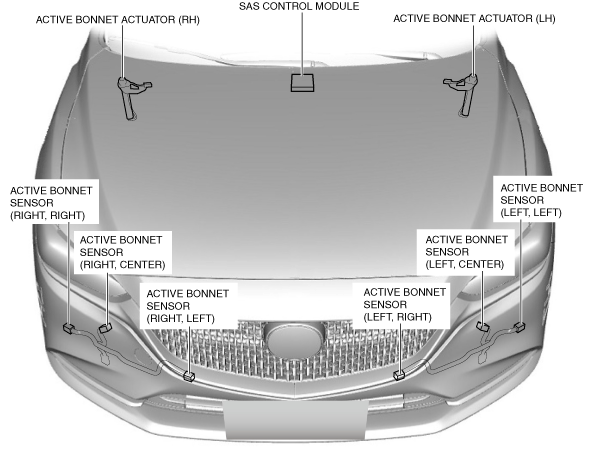ACTIVE BONNET
id081300010100
Outline
• If the vehicle hits a pedestrian while driving and a certain level of impact is applied to the front of the vehicle, the bonnet raises immediately to maintain a wide clearance between the bonnet and the parts in the engine compartment, reducing the impact to the pedestrian’s head.
-
Warning
-
• If the bonnet release handle is pulled after the active bonnet has deployed, the bonnet will rise even further. If the vehicle is driven with the bonnet raised it will obstruct visibility and could result in an accident.
• If a vehicle with a deployed active bonnet is to be driven, the raised bonnet may obstruct vision and it may lead to an accident. When driving a vehicle with a deployed active bonnet, verify that the raised bonnet does not obstruct vision and drive the vehicle at a low speed.
• Pressing down the raised bonnet after the active bonnet has deployed may lead to deformation of the bonnet or an injury. Do not press down the raised bonnet after the active bonnet has deployed because it cannot be pressed down manually.
• If the following parts are not replaced when servicing the vehicle after the active bonnet has deployed, the active bonnet may not function normally. When repairing a vehicle after the active bonnet has deployed, always replace them with new parts no matter to what extent the external damage appears.
-
― Active bonnet actuator
― Active bonnet sensor
― SAS control module
― Bonnet
― Bonnet hinge
― Bonnet striker
― Bonnet latch
― Front bumper (during collision)
― Bumper retainer (during collision)
Function
System conditions display function
-
• The active bonnet detects each part condition and sends a system condition signal from the SAS control module to the instrument cluster.
• The instrument cluster indicates the following warning light and activates the alarm based on the system condition signal.
|
Warning light and alarm
|
Reference
|
|
Active bonnet warning light
|
|
|
Active bonnet warning alarm
|
|
Structural View
System Wiring Diagram
Operation
Operation condition
-
• If the vehicle is involved in a frontal collision and all the following conditions are met, the SAS control module activates the active bonnet actuators to raise the bonnet.
|
Transmission sensor/module
|
Signal name
|
Operation condition
|
|
Active bonnet sensor
|
Collision detection signal
|
Collision impact is set value or more
|
|
PCM
|
Vehicle speed signal
|
Vehicle speed during collision is within set range (mid-speed range)
|
1. When the vehicle receives an impact (1) from the vehicle front, the crash sensor (2) built in the active bonnet sensor detects the impact and converts the impact into an electrical signal using the signal processing circuit (3).
2. The SAS control module calculates (6) the degree of impact using the determination and safing circuit (5) based on the electric signal (4) from each crash sensor.
3. If the vehicle speed at the timing the impact is detected is within the set range and the impact exceeds the preset threshold, the SAS control module outputs (8) an operation signal to the active bonnet actuator using the output control circuit (7).
4. The active bonnet actuator operates (9) based on the operation signal from the SAS control module.
5. When the active bonnet actuator operates, the piston pops out and raises the bonnet.
6. When the bonnet is raised by the piston, the bonnet hinge moves and the rear side of the bonnet pops up (11).
